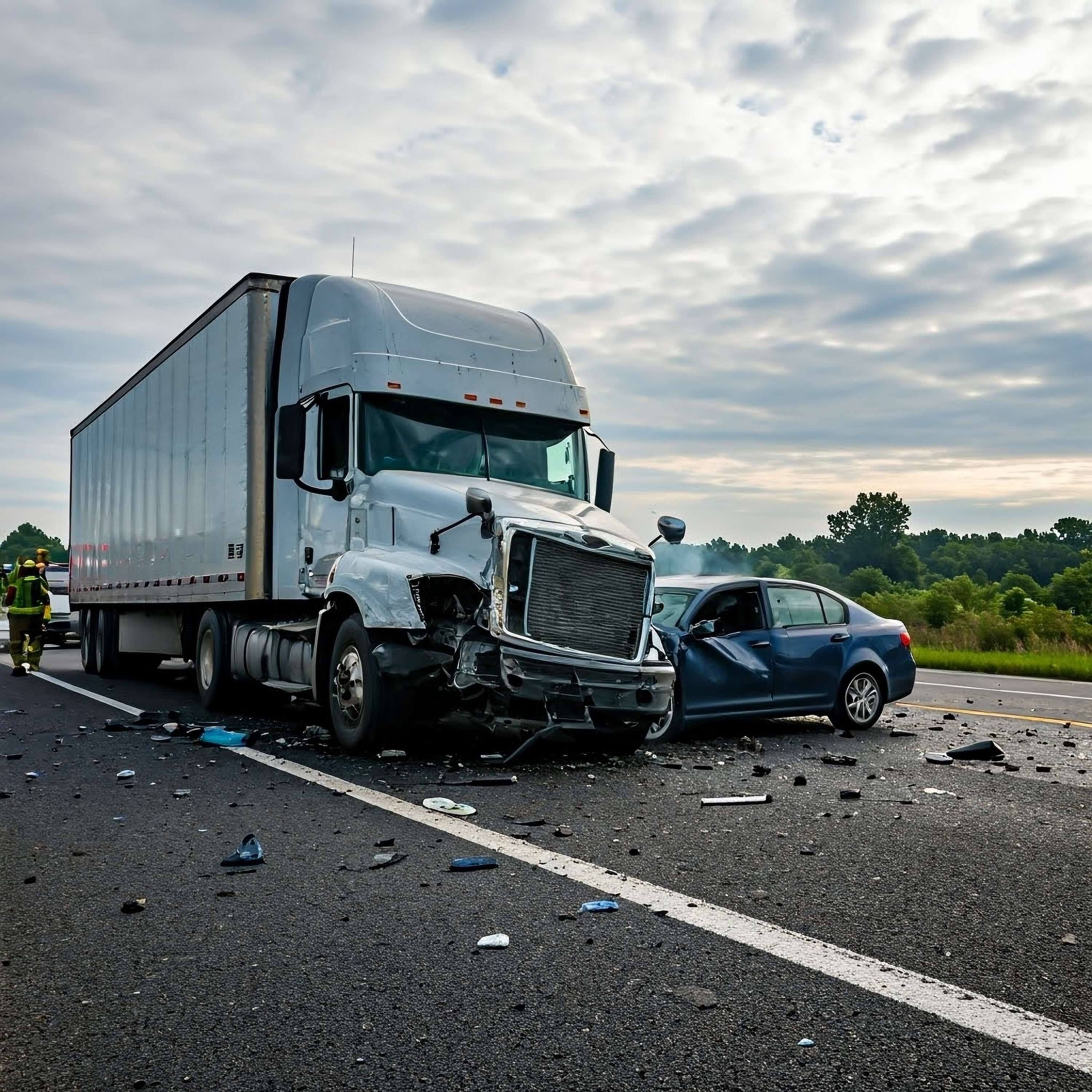Differences Between Semi-Truck and Delivery Truck Crashes

Written by Molly A. Ullrich

Understanding the differences between semi-truck and delivery truck crashes can help you better assess risks on the road. These vehicles vary greatly in size, weight, and operating conditions, directly affecting how accidents occur and their severity.
Semi-truck crashes often involve higher speeds and more severe damage due to their larger size and heavier loads, while delivery truck crashes tend to happen at lower speeds, often in urban areas with more frequent stops. Knowing these distinctions can guide you in avoiding accidents and responding appropriately if one occurs.
Key Structural Differences Between Semi-Truck and Delivery Truck Crashes
Size, Weight, and Design Factors
Semi-trucks are significantly larger and heavier than delivery trucks. A fully loaded semi can weigh up to 80,000 pounds, compared to delivery trucks usually ranging from 10,000 to 33,000 pounds.
Drivers must consider the semi’s design, including a tractor and a separate trailer, which alters how forces are distributed during a crash. Delivery trucks are often single-unit vehicles, affecting impact dynamics differently.
Because semi-trucks sit higher off the ground, their collisions often involve underride risks, where smaller vehicles slide under the trailer. Delivery trucks have lower profiles, changing the nature of crash impact zones.
Cargo Capacity and Vehicle Purpose
Semi-trucks transport large commercial loads, often spanning long distances, with trailers built to carry thousands of pounds. This cargo capacity contributes to the truck’s mass and influences crash severity. Delivery trucks primarily serve local routes with smaller, more varied cargo loads. Their structural frames and suspension systems reflect this lighter use and shorter distance design.
Awareness of cargo types is important; semi-trucks’ heavier payloads increase stopping distances and crash impact forces. Delivery trucks, with lighter cargo, generally have different braking and handling characteristics, impacting crash outcomes.
Mechanics of Collision Impact
In crashes, semi-trucks’ mass causes greater momentum and kinetic energy, resulting in more forceful impacts. Their articulated design can lead to jackknifing, increasing crash complexity.
Delivery trucks have less mass and a rigid frame, which often results in different impact points and damage patterns. Their collisions may involve quicker deceleration but less secondary motion than semi-trucks.
Both vehicles transfer crash forces differently to their occupants and others on the road. Semi-truck crashes often result in larger intrusion zones, while delivery truck crashes tend to localize damage around the cabin or front end.
Distinct Causes and Circumstances of Semi-Truck Versus Delivery Truck Accidents
Dominant Risk Factors for Semi-Truck Accidents
Semi-truck crashes often happen due to long hours spent on highways, where fatigue plays a major role. Drivers may be pushed by deadlines, leading to reduced reaction times and impaired judgment.
Other key factors include speeding, poor vehicle maintenance, and blind spots. The large size of semi-trucks makes maneuvering difficult, especially during lane changes or turning, increasing collision risks.
Weather conditions like rain or fog can also contribute heavily by reducing visibility and road traction. Collisions involving semi-trucks often result in severe damage due to their mass and momentum.
Unique Hazards Associated with Delivery Trucks
Delivery trucks typically operate in urban or suburban settings, where there are different risks. Frequent stops, tight turns, and pedestrian activity create complex driving conditions.
Rear-end collisions and side-swipes are common because delivery trucks often enter and exit traffic abruptly. Limited rear visibility and narrow streets add to these hazards.
Additionally, delivery drivers may be less trained for defensive driving compared to long-haul truckers. They often deal with increased distractions from navigation devices or package handling while driving.
Legal and Insurance Implications in Semi-Truck and Delivery Truck Crashes
Legal Challenges in Semi-Truck Accident Claims
Semi-truck crashes often involve federal regulations, including hours-of-service rules and vehicle maintenance standards. You need to consider these regulations because violations can strongly affect liability.
Cases frequently require expert testimony on trucking company policies, driver logs, and cargo securing. You might also encounter multiple liable parties, such as the trucking company, cargo owners, and manufacturers.
Because of the truck’s size and commercial nature, semi-truck accident claims often involve higher damages and more complex investigations. You should expect longer legal timelines and more detailed discovery processes.
Legal Complexities in Delivery Truck Crash Cases
Delivery truck accidents usually involve local or state laws rather than federal regulations. Insurance policies for these vehicles tend to be different, often issued through commercial insurers with specific coverage limits.
You must examine the employment status of the driver carefully, whether they are an employee or an independent contractor, as this affects liability. Additionally, delivery trucks often have smaller cargo, so issues around property damage and injury claims may differ.
The fewer regulatory hurdles compared to semi-trucks can simplify some parts of the legal process. However, determining fault may still be complex when multiple parties, such as contractors or subcontractors, are involved.
Impact on Insurance Claims and Liability Determination
Insurance claims involving semi-trucks usually require interaction with commercial trucking insurers who have extensive experience handling large claims. You might deal with higher policy limits and added layers of coverage like umbrella policies.
Delivery truck claims often involve smaller policy limits but can be complicated by who insures the vehicle—the trucking company or a third-party logistics provider. This affects how liability is determined and who ultimately pays.
Your ability to prove fault impacts claim outcomes in both types of crashes. Detailed evidence, such as driver logs or maintenance records for semi-trucks, and employment contracts for delivery trucks, can determine how insurers assign responsibility.

Investigation, Prevention, and Handling of Truck Accidents
Investigative Strategies for Both Crash Types
When investigating semi-truck and delivery truck crashes, you should note key distinctions. Semi-truck accidents often require examination of electronic logging devices, brake system inspections, and cargo load analysis. Delivery truck crashes might focus more on route tracking and driver schedules due to shorter trips.
You or your legal team will need access to driver logs, vehicle maintenance records, and eyewitness statements. Additionally, accident reconstruction experts play a vital role in both cases but might emphasize different vehicle dynamics. For example, semi-trucks involve heavier weight and longer stopping distances.
Both types of investigations demand thorough documentation of weather, road conditions, and vehicle damage to build a strong case.
Effective Safety Measures and Prevention Tips
To lower risk, companies should focus on specific safety protocols tailored to each truck type. Semi-truck operators benefit from regular brake and tire inspections, fatigue management programs, and strict adherence to hours-of-service regulations. These measures address long-haul driving challenges.
Delivery trucks require tight scheduling controls and clear route planning to avoid fatigue and excessive speed in urban areas. Training drivers on blind spots and immediate hazard recognition is critical for both truck types. Safety checklist for a truck fleet:
- Regular mechanical inspections
- Driver training on defensive driving
- Compliance with federal and state regulations
- Use of advanced safety technology, like automatic emergency braking
Smith & Weidinger PLLC’s Methodology
Smith & Weidinger PLLC employs a targeted approach when handling truck accident claims. Your case benefits from early evidence collection focused on driver logs and vehicle inspection reports. We understand the technical layers of semi-truck and delivery truck operations.
Your legal team works with specialized accident reconstruction experts and trucking industry consultants to clarify liability. They prioritize gathering data from onboard systems, including GPS and electronic logging devices, which are crucial in disproving or confirming fault.
Smith & Weidinger PLLC also emphasizes clear communication with regulatory agencies and negotiates effectively with insurance companies to protect your rights and seek fair compensation.
Note: The information provided in this blog post has been compiled from publicly available and secondary sources. While we strive for accuracy, some details may become outdated or contain inadvertent errors. If you believe any information is incorrect or requires updating, please contact Smith & Weidinger so that we may review and make the appropriate corrections.
Disclaimer: This blog post is for informational purposes only and is not intended as a solicitation for business. The photo used is not from the scene of the incident described. Viewing this content does not create an attorney-client relationship with Smith & Weidinger. If you have been injured in an accident, please seek immediate medical attention and then consult with a qualified attorney to discuss your legal rights and options.










